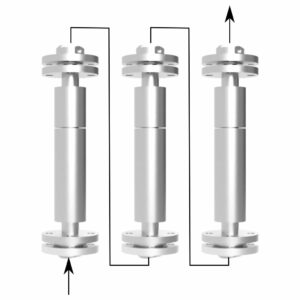What are the key considerations, problems and solutions when scaling up a continuous process from lab to production scale? We discuss these points and recommend further reading.
Flow chemistry improves heat and mass transfer in chemical processes. These technical benefits could reduce energy, material, and costs by 10-80%. More details are discussed in our article on flow chemistry benefits.
Updated on 6 Feb 2023, by Ed Bainbridge, Chemical Engineer

Why scaling up is fundamentally difficult?
Making anything bigger requires more materials, time, and effort. Do the same rules apply to continuous processes?
There is a lot more to scaling up than simply making something bigger – there are a lot of questions and compromises. These are not simply balancing costs and performance, but balancing between fundamental trade-offs.
Process properties and equipment performance changes dramatically on scale-up:
| Property | Production scale | Lab scale |
| Heat generation | 1,000+ kW | 0.001 kW |
| Surface to volume ratio | 5 m2/m3 | 100 m2/m3 |
| Hazard (worst-case material release) | 1,000+ L | 0.1 L |
| Mixing | 1m from mixer | 0.03m from mixer |
| Costs (capital) | 50 $ / m3 | 500+ $ / m3 |
These limited examples show that a simply bigger reactor would perform substantially different to the laboratory reactor. The production reactor will heat slower, may be unable to manage the process exotherm and the worst-case hazard could be catastrophic.
What are the standard approaches to scale-up?
Flow reactor scale-up
Scaling up a process can be complex, requiring a lot of research, time, and money. Our multi-CSTR reactors, accelerate development and reduce risks in process scale-up.
The major problems of scale-up lie in maintaining heat transfer and mixing. These are related to each other because the increased mixing improves heat transfer.
Standard scaling-up approaches
Several review articles discuss scale-up in detail, for example, “Scale-up of micro- and milli-reactors: An overview of strategies, design principles and applications” by Simon Kuhn, Tim Noel and coworkers. This review mainly refers to conventional (statically mixed such as tubular) reactors. We discuss a more general case of scaling up statically mixed agitated continuous reactors that provide decouple mixing from the flow rate and provide a wider range of operating parameters.

Scaling up by numbering up
Numbering up is a method usually applied to tubular reactors, which also could be applied to the SABRe. This method involves putting multiple reactors in parallel to each other. It is an obvious solution that maintains the exceptional performance of the lab-scale systems – because the lab-scale systems are used.
The main problem in numbering up, however, is cost. A 100-fold larger reactor would cost at least 100 times as much. Moreover, connecting 100 reactors would require an expensive and specifically designed flow distributor. Having multiple connections would make the overall system dramatically less robust and reliable.

Scaling up by length
A less common approach to scale-up is to maintain channel diameter and increase the length. This approach is popular in laboratory-scale tubular reactors, but it can be applied to other flow reactors. The main advantage, compared to numbering up, is the removal of the flow distributor.
Although this may be an effective solution for scaling up by a small factor, it greatly increases the pressure drop and is an expensive solution – the costs increase with the number of units.
Rational scale-up
There is no perfect scale-up approach – the particular approach depends on the required scale-up factor, hazard, process and system properties. Yet, there are several general techniques focused on reducing uncertainty and guiding towards a good compromise. These are discussed in the book by E. B. Nauman, Chemical Reactor Design, Optimization, and Scaleup, McGRAW-HILL, 2002.
- Geometric similarity (D/T)
- Constant power per volume
- Constant pressure drop
- Constant mixing time
- Constant surface/volume
We find that in flow chemistry, two major scale-up problems are heat transfer and mixing. Hence, the questions are how to maintain mixing and heat transfer.

Maintaining Mixing
Different methods exist for keeping mixing constant when scaling stirred tanks. Perhaps the simplest is keeping geometric similarity, especially the impeller diameter to tank diameter ratio (D/T ratio). If the D/T ratio is the same, and the tip speed of the impeller is also the same, mixing will be similar.
Constant power per volume is also a commonly used technique used to scale up stirred tanks. The impeller power is difficult to measure at a small scale, but it could be estimated with the power number. The Handbook of Industrial Mixing provides excellent details on such estimations and scale-up – E. Paul, V. Atiemo-Obeng and S. Kresta, Handbook of Industrial Mixing, 2015.

Maintaining Heat Transfer
Two parameters are important when scaling heat transfer: the surface area to volume ratio and the overall heat transfer coefficient (U). When a cylindrical vessel is enlarged, the surface area/volume decreases. Also, the walls get thicker to maintain the pressure rating further decreasing the heat transfer rate. The graph shows the relationship between cylinder size and surface area/volume ratio (neglecting the ends of the cylinder).
The heat transfer, however, could be maintained – we added additional internal heat exchangers into our reactor to maintain the same heat transfer rate as in the 120 mL lab-scale system.

Conclusion
There are many challenges in scaling-up flow chemistry and there is no solutions that fit every purpose.
Our multi-CSTR reactors decouple mixing and heat transfer from the fluid velocity. This alone allows for much greater flexibility and a broader range of process conditions compared to the standard tubular reactors. On scaling up from 0.1L to 100L, we manage to maintain the same mixing and heat transfer performance to reduce risks and accelerate scale-up.

